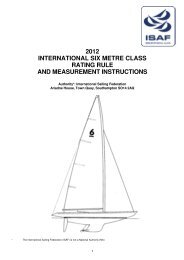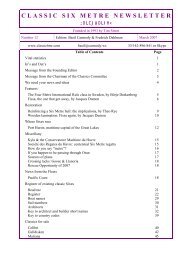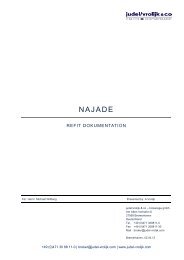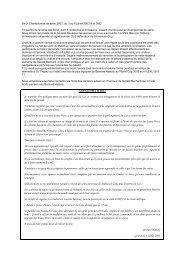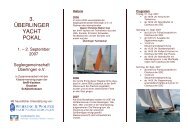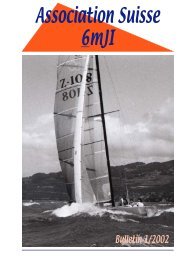CLASSIC SIX METRE NEWSLETTER
CLASSIC SIX METRE NEWSLETTER
CLASSIC SIX METRE NEWSLETTER
You also want an ePaper? Increase the reach of your titles
YUMPU automatically turns print PDFs into web optimized ePapers that Google loves.
Reinforcing a wooden hull to resist the stresses of modern sails<br />
Reinforcing a wooden 6mR hull, by Theo Rye<br />
Wooden 6 metre hulls, especially those with long overhangs, present an interesting set of<br />
design issues. One of the most common is how to reinforce the hull to resist the higher loads<br />
of a modern rig.<br />
As long as we were happy to stick to the old way of things, with spruce masts and “soft” sails,<br />
everything was fine. The problems started with alloy masts; then rod rigging, and laminate<br />
sails; in order to get these things to work well, the rigging had to be set up tighter and tighter.<br />
It worked, but many of the older carvel hulls fitted with modern rigs were soon showing signs<br />
of hard usage; splines or seams cracking and opening, garboards leaking, decks hogging.<br />
The first thing to understand is that, generally, traditional yachts are pretty good at resisting<br />
the loads they were designed for: they keep the seawater out (from below, at any rate), and<br />
rarely break. Occasionally very old yachts do “sag” at the ends a bit; but generally that’s<br />
after a long hard life. Put a modern rig in though, and wind it up a bit, and things soon<br />
change.<br />
Broadly speaking you can break the sources of these loads down in ascending order of<br />
concern;<br />
Standing backstay: rarely a major issue despite being right at the aft end of the overhang, as<br />
they are on the centreline, and not normally highly tensioned.<br />
Headsail sheets: usually only a cause of local problems as the loads are generally pretty flat<br />
to the deck.<br />
Halyards: Despite being so close to the critically loaded area of the mast, halyard loads are<br />
normally pretty easy to deal with by sensible local design.<br />
Mainsheet: Often a big load, but quite close to the centreline and again more often a source<br />
of local concerns (track pulling out) as it is usually far enough into the main body of the boat<br />
not to cause global bending issues.<br />
Headstay: This has to be taut for effective windward work, and the result is inevitably high<br />
loads on the centreline, often out at the end of a fine overhanging bow. On many older yachts<br />
the situation is even worse as the forestay is pushed forward from the original position in<br />
order to increase the J measurement.<br />
Shrouds: Shroud loadings are now typically high even at rest. They are pulling up and<br />
inboard, causing local deck compression transversely at the mast, and sometimes “hogging”<br />
the hull longitudinally as well.<br />
Running backstays: Usually the worst of the lot. In order to get good headstay tension,<br />
runners are placed as far aft as possible, and set up very tight; and the loads are cyclical and<br />
variable. Being offset from the centreline, they introduce a very nasty torsional (twisting)<br />
load in the hull which traditionally built carvel hulls are not good at resisting.<br />
Ultimately all these loads are the result of trying to keep the mast in the boat and reasonably<br />
straight. The mast itself is then pushing downwards on the step, generating big compressive<br />
loads.<br />
So how to work through that lot?<br />
- 11-



